On My Way To China
Download as pptx, pdf0 likes326 views
There are three plates with fortune cookies. Each plate has 3 fortune cookies, so there are 3 x 3 = 9 fortune cookies total.
1 of 21
Download to read offline
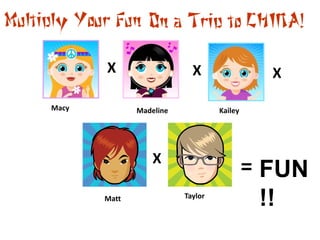
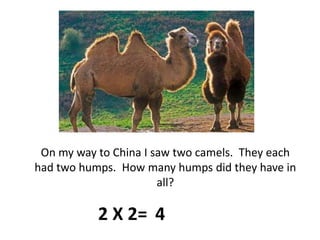
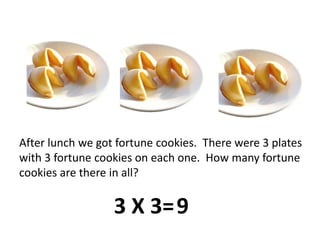
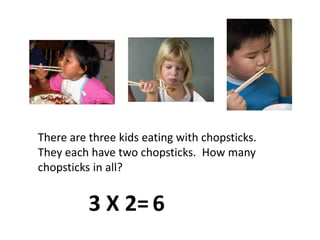

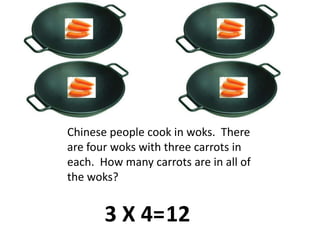
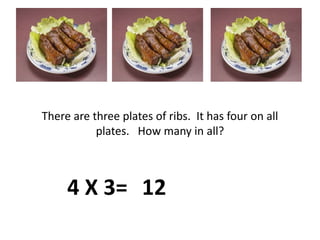
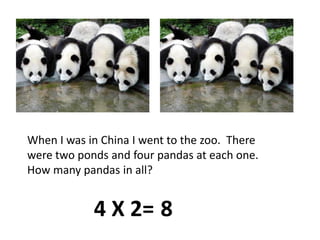
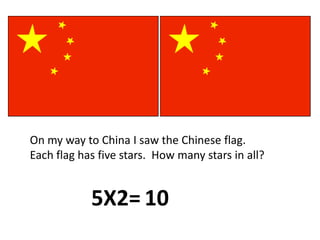
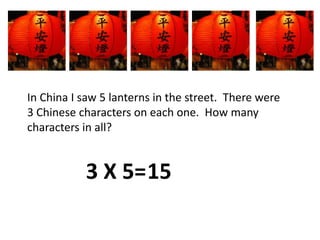


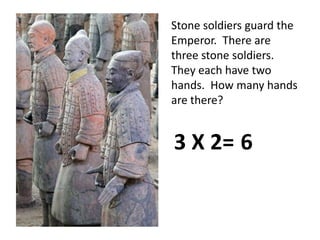
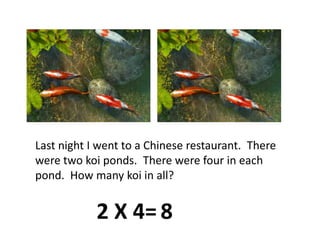
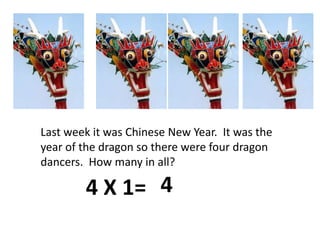
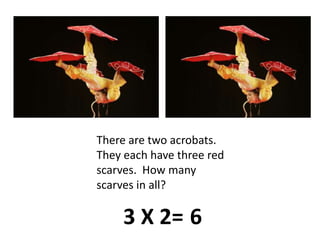

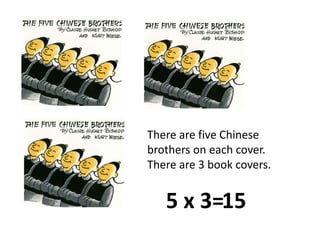

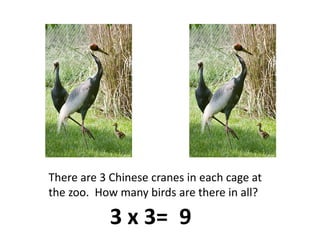
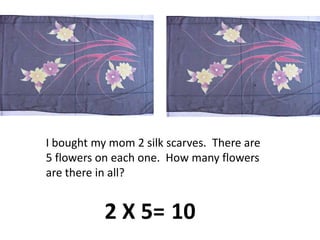
Ad
Recommended
Competencias, capacidades e indicadoresDiego Gabriel Gonz├Īlez Urbieta
╠²
Este documento define conceptos clave como competencias, capacidades e indicadores. Explica que las competencias son objetivos generales, las capacidades se refieren a unidades tem├Īticas espec├Łficas y los indicadores son actividades observables. Luego proporciona ejemplos de c├│mo estas definiciones se aplican en el contexto educativo para elaborar objetivos y evaluar el aprendizaje de los estudiantes.3B's Multiplication ║▌║▌▀Żshow
3B's Multiplication ║▌║▌▀ŻshowAndrea Sommers
╠²
There were 3 beds with 2 cats in each bed, so there were 3 x 2 = 6 cats total.
There were 3 blankets with 9 dogs on each blanket, so there were 9 x 3 = 27 dogs total.
Mom and I made 10 plates of cookies, with 5 cookies on each plate, so there were 5 x 10 = 50 cookies total.Math-Problems-of-the-Day-2nd-Grade.pptx
Math-Problems-of-the-Day-2nd-Grade.pptxGilDelena
╠²
The document provides a collection of word problems involving addition, subtraction, multiplication, and division of whole numbers. The problems cover a range of mathematical concepts including adding/subtracting to find a total, comparing quantities, and multi-step word problems involving multiple operations.Multiplication story problems
Multiplication story problemstruetken
╠²
The document contains word problems involving multiplication. Each problem introduces a scenario and asks how many of a certain item there are in total. The problems are then solved by identifying how many of the item are in each group and multiplying that number by the number of groups.Math Problems of the Day 4th Grade 4e annee
Math Problems of the Day 4th Grade 4e anneessuser2cd15b
╠²
The document presents a series of math problems covering various topics such as addition, subtraction, multiplication, division, fractions, and patterns. Each problem involves real-life scenarios that require calculation and logical reasoning to arrive at the correct answers. The problems range from simple arithmetic to moderate complexities involving money, measurements, and logical sequences.Equal Groups of Things
Equal Groups of Thingsjmsalsich
╠²
The document contains multiple word problems. Each word problem describes a set of objects (e.g. ladybugs, parrots), the number of those objects, and something each object has (e.g. spots, seeds). It then calculates the total number of that something by multiplying the number of objects by the number each object has.Math Problems of the Day - Kindergarten.pptx
Math Problems of the Day - Kindergarten.pptxPeterPiper19
╠²
The document contains a series of simple math problems focused on addition, subtraction, and patterns, aimed at young learners. It includes various everyday scenarios involving counting and comparing quantities, such as items owned by individuals, animals, and objects. The problems encourage basic arithmetic skills and logical reasoning.Home Learning 23.03.2020
Home Learning 23.03.2020MissBebber
╠²
This document provides a home learning plan for children with various activities organized by subject for each day of the week. The activities include reading, writing, maths, physical exercise, and other subjects. Daily maths activities focus on skills like column addition, subtraction, and word problems. Other activities cover topics in languages, geography, history, and more. Children are encouraged to keep a diary and record their thoughts. The document aims to engage children in continuous learning at home during periods away from school.grade power point presentation on math subjects
grade power point presentation on math subjectspoligroj24
╠²
The document covers various topics related to mathematics, including solving equations, addition property of equality, and word problems involving time, distance, and geometry. It also includes exercises and activities for grade 5 students to practice their problem-solving skills. Additionally, it introduces concepts such as volume, data organization, and systematic listing using tree diagrams.2014.12.01 michael word problem y1
2014.12.01 michael word problem y1missredgate
╠²
This document contains 30 word problems for year 1 students involving addition, subtraction, multiplication and other basic math concepts. The problems ask students to calculate things like the number of stickers or dolls needed to match amounts, costs of toys, numbers of objects, time differences and more. Solving the problems requires applying mathematical operations to quantities provided in each short scenario.Summer requirements & supply list
Summer requirements & supply listPatricia Bernstein
╠²
The document provides a supply list for a third grade classroom for the entire school year, including items such as pencils, glue sticks, folders, and tissues. It also lists optional supplies for whole class use like hand sanitizer and disinfecting wipes. Students are asked to label all supplies with their name before bringing them to class.100 Mental Mathematics starters for kids
100 Mental Mathematics starters for kidsLENLYESPANOL2
╠²
The document consists of a series of mental math problems aimed at children, covering various topics including basic operations with apples, lollies, marbles, and money. It includes word problems that encourage problem-solving skills involving addition, subtraction, multiplication, and division in real-life contexts. Additionally, it addresses concepts such as time, shapes, and measurements in an engaging way.Mathematics for grade 3 teachers
Mathematics for grade 3 teachersEDITHA HONRADEZ
╠²
This document provides an overview of mathematics concepts and skills for grade 3 teachers. It covers understanding numbers, addition, subtraction, multiplication, and calendars. Some key points:
- Section I covers place value, writing numbers, comparing numbers, and basic operations including addition, subtraction, and multiplication word problems.
- Section II covers additional concepts like place value, addition, subtraction, and using calendars including finding dates, days of the week, and performing basic operations with dates.
- Section III focuses more on multiplication, including multiplication tables, multi-step word problems, and explaining how entries in the multiplication table are obtained.
The document is a comprehensive guide to core third grade math topics to help teachers understand thePruebas saber ingles 3┬░ y 4┬░
Pruebas saber ingles 3┬░ y 4┬░Isabel Pino
╠²
The document appears to be an English test for grade 3 students, as it contains listening, reading, writing, matching, and math problems. The test covers topics such as dates, adjectives, addition, subtraction, and reading comprehension. Students are instructed to choose answers, write, draw, listen, match, read, and complete various questions and activities.Addition examples
Addition examplesErika Crawford
╠²
The document provides examples of addition word problems with numbers and pictures. It presents up to two addends in each problem and shows the setup and solution for calculating the total. The problems cover topics like counting coins, cows, stamps, calculating distances traveled, quantities of pumpkins/gourds/juices, numbers of globes/maps/books/horses/lighthouses. The document encourages the reader to identify the relevant numbers in each case and find the total by adding the given addends.addition - subtraction - picture dictation.pptx
addition - subtraction - picture dictation.pptxnidasevall
╠²
The document includes various topics, such as emotions, the life of Ernő Rubik, and activities related to a picture dictation exercise. It contains math problems involving addition and subtraction, word problems, and discussions on scenarios like the number of fruits, candies, and classroom dynamics. Overall, it is an educational resource aimed at teaching basic math and comprehension skills.Math rhymes
Math rhymesritenitis
╠²
The document provides several English rhymes and finger plays that can help young children learn numeracy skills. It includes rhymes for counting from 1 to 10, as well as rhymes involving addition, subtraction and colors. Actions are described to accompany the rhymes and reinforce the concepts. Reciting rhymes is presented as an engaging way for children to learn numbers and counting in a playful way.1st Grade Skills Review
1st Grade Skills ReviewJamila Colbert
╠²
The document is a review of 1st-grade math, reading, and social studies skills, covering topics such as telling time, basic equations, shapes, fractions, verbs, nouns, and character identification in stories. It includes exercises for identifying lengths, finding sums and differences, understanding nouns and verbs, and recognizing continents and oceans. Overall, it serves as a comprehensive review of essential skills for first-grade students.Presentation math 105
Presentation math 105Erika Crawford
╠²
The document provides examples of addition word problems and their step-by-step solutions. It contains over 20 different word problems involving adding various numbers of objects such as coins, cows, stamps, miles traveled, pumpkins, globes, maps, books, juice boxes, horses, and lighthouses. The document encourages the reader to solve each problem, then provides the solution and setup for checking the answer.Fraction conundrums
Fraction conundrumsnavajomath
╠²
1) If 300 toys are blue, and 3/10 of the toys were originally blue and 1/4 of the remaining were green, then there must have been 1000 toys total. Half of the remaining after blue and green were red (250) and half were yellow (250).
2) If 7/10 of the students chose the healthier spinach option and the other 90 chose canned corn, then there must have been 100 students total.
3) If Sybil has crawled 12 more inches and will then have completed 7/10 of the race, and we know she has already completed half, then the full race must be 30 inches long.11.14.11 classwork monday
11.14.11 classwork mondaymrlafrossia
╠²
After finding your teddy bear sitting at your desk doing your homework, you discover that it has finished all of your assignments correctly. You are surprised by this turn of events but appreciate having the homework done.GRADE 1 SESSION 2.pptx
GRADE 1 SESSION 2.pptxLuisSalenga1
╠²
This document contains a grade 1 math lesson plan covering various number sense topics:
- Counting sets of ones and tens and regrouping them
- Writing numbers as tens and ones
- Adding and subtracting tens and ones
- Word problems involving addition and subtraction of amounts less than 100
The lesson includes guided practice problems for students to work through with explanations for the answers. It also has a challenge section at the end with slightly more difficult multi-step word problems for additional practice.Math problems
Math problemsAndreeaAlice
╠²
1) The document contains multiple math word problems and questions. It asks to determine if a division problem is positive or negative, compare areas of countries, calculate remaining distance in a journey, find the length of one side of a square given the perimeter, and perform other calculations involving numbers, rates, and quantities.
2) It provides data like country areas, distances traveled, numbers of items, and rates to use in solving the problems.
3) The questions require calculating totals, differences, smallest/largest values, and ordering items to answer questions about quantities, rates, and relationships between numbers.Harmony Elementary 1st Grade Homework
Harmony Elementary 1st Grade Homework HES-1stGrade
╠²
This document outlines the homework assignments for 1st grade students at Harmony Elementary for the month of October. Each week focuses on different sight words and includes assignments in writing, math, and reading. Writing assignments involve composing stories about family activities or messes made. Math assignments include using pictures, words and numbers to solve problems involving counting objects, number lines and doubles facts. Reading assignments consist of practicing with books from the reading bag each night.Grade 4 word problem
Grade 4 word problemPuneet Chawla
╠²
The document provides information about various countries' areas in square kilometers, and then presents 17 multi-step word problems involving distances, rates, money, geometry, and more. It concludes by listing the answers to the 17 problems.Oxford activity book for children 1
Oxford activity book for children 1Luiz Santos
╠²
This document is the copyright page from an Oxford University Press activity book for children. It lists the publisher's address and other publishing details such as associated companies, year of publication, and conditions of sale. It also provides the ISBN number for identifying the book.Activity book for children 1 pdf
Activity book for children 1 pdfVanessa Alvarez Alvarez
╠²
This document is the copyright page from an Oxford University Press activity book for children. It lists the publisher's address and other publishing details such as associated companies, year of publication, and conditions of sale. It also provides the ISBN number for identifying the book.Japan
JapanLee De Groft
╠²
1) The document introduces a class trip to Japan, providing background about the country's geography, population, exports, and history.
2) Japan is an island country with little farmland due to its mountainous terrain, forcing it to import food and rely on manufacturing and technology.
3) The country is prone to earthquakes but has advanced infrastructure like bullet trains to accommodate its large population within a small land area. Major cities include Tokyo and Osaka.Then&Now
Then&NowLee De Groft
╠²
Schools have changed significantly over time. In the past, schools had one large room for all ages and grades, outhouses instead of indoor plumbing, and students played outside rather than in gyms. Now, schools have multiple classrooms for different grades, indoor plumbing, and designated play areas. School supplies have also modernized, transitioning from slate boards and ink pens to notebooks, computers, and various art supplies. Studies have expanded from a focus on basic reading, writing, and arithmetic to include additional subjects like science, music, history, and computer classes. Toys and transportation have also modernized, becoming more varied in materials, designs, and functionality.More Related Content
Similar to On My Way To China (20)
grade power point presentation on math subjects
grade power point presentation on math subjectspoligroj24
╠²
The document covers various topics related to mathematics, including solving equations, addition property of equality, and word problems involving time, distance, and geometry. It also includes exercises and activities for grade 5 students to practice their problem-solving skills. Additionally, it introduces concepts such as volume, data organization, and systematic listing using tree diagrams.2014.12.01 michael word problem y1
2014.12.01 michael word problem y1missredgate
╠²
This document contains 30 word problems for year 1 students involving addition, subtraction, multiplication and other basic math concepts. The problems ask students to calculate things like the number of stickers or dolls needed to match amounts, costs of toys, numbers of objects, time differences and more. Solving the problems requires applying mathematical operations to quantities provided in each short scenario.Summer requirements & supply list
Summer requirements & supply listPatricia Bernstein
╠²
The document provides a supply list for a third grade classroom for the entire school year, including items such as pencils, glue sticks, folders, and tissues. It also lists optional supplies for whole class use like hand sanitizer and disinfecting wipes. Students are asked to label all supplies with their name before bringing them to class.100 Mental Mathematics starters for kids
100 Mental Mathematics starters for kidsLENLYESPANOL2
╠²
The document consists of a series of mental math problems aimed at children, covering various topics including basic operations with apples, lollies, marbles, and money. It includes word problems that encourage problem-solving skills involving addition, subtraction, multiplication, and division in real-life contexts. Additionally, it addresses concepts such as time, shapes, and measurements in an engaging way.Mathematics for grade 3 teachers
Mathematics for grade 3 teachersEDITHA HONRADEZ
╠²
This document provides an overview of mathematics concepts and skills for grade 3 teachers. It covers understanding numbers, addition, subtraction, multiplication, and calendars. Some key points:
- Section I covers place value, writing numbers, comparing numbers, and basic operations including addition, subtraction, and multiplication word problems.
- Section II covers additional concepts like place value, addition, subtraction, and using calendars including finding dates, days of the week, and performing basic operations with dates.
- Section III focuses more on multiplication, including multiplication tables, multi-step word problems, and explaining how entries in the multiplication table are obtained.
The document is a comprehensive guide to core third grade math topics to help teachers understand thePruebas saber ingles 3┬░ y 4┬░
Pruebas saber ingles 3┬░ y 4┬░Isabel Pino
╠²
The document appears to be an English test for grade 3 students, as it contains listening, reading, writing, matching, and math problems. The test covers topics such as dates, adjectives, addition, subtraction, and reading comprehension. Students are instructed to choose answers, write, draw, listen, match, read, and complete various questions and activities.Addition examples
Addition examplesErika Crawford
╠²
The document provides examples of addition word problems with numbers and pictures. It presents up to two addends in each problem and shows the setup and solution for calculating the total. The problems cover topics like counting coins, cows, stamps, calculating distances traveled, quantities of pumpkins/gourds/juices, numbers of globes/maps/books/horses/lighthouses. The document encourages the reader to identify the relevant numbers in each case and find the total by adding the given addends.addition - subtraction - picture dictation.pptx
addition - subtraction - picture dictation.pptxnidasevall
╠²
The document includes various topics, such as emotions, the life of Ernő Rubik, and activities related to a picture dictation exercise. It contains math problems involving addition and subtraction, word problems, and discussions on scenarios like the number of fruits, candies, and classroom dynamics. Overall, it is an educational resource aimed at teaching basic math and comprehension skills.Math rhymes
Math rhymesritenitis
╠²
The document provides several English rhymes and finger plays that can help young children learn numeracy skills. It includes rhymes for counting from 1 to 10, as well as rhymes involving addition, subtraction and colors. Actions are described to accompany the rhymes and reinforce the concepts. Reciting rhymes is presented as an engaging way for children to learn numbers and counting in a playful way.1st Grade Skills Review
1st Grade Skills ReviewJamila Colbert
╠²
The document is a review of 1st-grade math, reading, and social studies skills, covering topics such as telling time, basic equations, shapes, fractions, verbs, nouns, and character identification in stories. It includes exercises for identifying lengths, finding sums and differences, understanding nouns and verbs, and recognizing continents and oceans. Overall, it serves as a comprehensive review of essential skills for first-grade students.Presentation math 105
Presentation math 105Erika Crawford
╠²
The document provides examples of addition word problems and their step-by-step solutions. It contains over 20 different word problems involving adding various numbers of objects such as coins, cows, stamps, miles traveled, pumpkins, globes, maps, books, juice boxes, horses, and lighthouses. The document encourages the reader to solve each problem, then provides the solution and setup for checking the answer.Fraction conundrums
Fraction conundrumsnavajomath
╠²
1) If 300 toys are blue, and 3/10 of the toys were originally blue and 1/4 of the remaining were green, then there must have been 1000 toys total. Half of the remaining after blue and green were red (250) and half were yellow (250).
2) If 7/10 of the students chose the healthier spinach option and the other 90 chose canned corn, then there must have been 100 students total.
3) If Sybil has crawled 12 more inches and will then have completed 7/10 of the race, and we know she has already completed half, then the full race must be 30 inches long.11.14.11 classwork monday
11.14.11 classwork mondaymrlafrossia
╠²
After finding your teddy bear sitting at your desk doing your homework, you discover that it has finished all of your assignments correctly. You are surprised by this turn of events but appreciate having the homework done.GRADE 1 SESSION 2.pptx
GRADE 1 SESSION 2.pptxLuisSalenga1
╠²
This document contains a grade 1 math lesson plan covering various number sense topics:
- Counting sets of ones and tens and regrouping them
- Writing numbers as tens and ones
- Adding and subtracting tens and ones
- Word problems involving addition and subtraction of amounts less than 100
The lesson includes guided practice problems for students to work through with explanations for the answers. It also has a challenge section at the end with slightly more difficult multi-step word problems for additional practice.Math problems
Math problemsAndreeaAlice
╠²
1) The document contains multiple math word problems and questions. It asks to determine if a division problem is positive or negative, compare areas of countries, calculate remaining distance in a journey, find the length of one side of a square given the perimeter, and perform other calculations involving numbers, rates, and quantities.
2) It provides data like country areas, distances traveled, numbers of items, and rates to use in solving the problems.
3) The questions require calculating totals, differences, smallest/largest values, and ordering items to answer questions about quantities, rates, and relationships between numbers.Harmony Elementary 1st Grade Homework
Harmony Elementary 1st Grade Homework HES-1stGrade
╠²
This document outlines the homework assignments for 1st grade students at Harmony Elementary for the month of October. Each week focuses on different sight words and includes assignments in writing, math, and reading. Writing assignments involve composing stories about family activities or messes made. Math assignments include using pictures, words and numbers to solve problems involving counting objects, number lines and doubles facts. Reading assignments consist of practicing with books from the reading bag each night.Grade 4 word problem
Grade 4 word problemPuneet Chawla
╠²
The document provides information about various countries' areas in square kilometers, and then presents 17 multi-step word problems involving distances, rates, money, geometry, and more. It concludes by listing the answers to the 17 problems.Oxford activity book for children 1
Oxford activity book for children 1Luiz Santos
╠²
This document is the copyright page from an Oxford University Press activity book for children. It lists the publisher's address and other publishing details such as associated companies, year of publication, and conditions of sale. It also provides the ISBN number for identifying the book.Activity book for children 1 pdf
Activity book for children 1 pdfVanessa Alvarez Alvarez
╠²
This document is the copyright page from an Oxford University Press activity book for children. It lists the publisher's address and other publishing details such as associated companies, year of publication, and conditions of sale. It also provides the ISBN number for identifying the book.More from Lee De Groft (15)
Japan
JapanLee De Groft
╠²
1) The document introduces a class trip to Japan, providing background about the country's geography, population, exports, and history.
2) Japan is an island country with little farmland due to its mountainous terrain, forcing it to import food and rely on manufacturing and technology.
3) The country is prone to earthquakes but has advanced infrastructure like bullet trains to accommodate its large population within a small land area. Major cities include Tokyo and Osaka.Then&Now
Then&NowLee De Groft
╠²
Schools have changed significantly over time. In the past, schools had one large room for all ages and grades, outhouses instead of indoor plumbing, and students played outside rather than in gyms. Now, schools have multiple classrooms for different grades, indoor plumbing, and designated play areas. School supplies have also modernized, transitioning from slate boards and ink pens to notebooks, computers, and various art supplies. Studies have expanded from a focus on basic reading, writing, and arithmetic to include additional subjects like science, music, history, and computer classes. Toys and transportation have also modernized, becoming more varied in materials, designs, and functionality.Brave Irene Verbs
Brave Irene VerbsLee De Groft
╠²
The document appears to be a story or lesson about a character named Irene and includes a list of vocabulary words related to winter weather and movement. Some of the vocabulary words that flashed on the screen briefly include howling, snatched, whipped, whirled, wind, and stumble. It seems to be describing Irene braving harsh winter conditions as she walks through snow while strong winds blow.Librarian of Basra
Librarian of BasraLee De Groft
╠²
A young child living in Iraq in 2003 experienced bombs falling and buildings burning as a library in their city of Basra was about to be destroyed, while elsewhere in the world the Tampa Bay Buccaneers won the Super Bowl and American Idol was starting its second year. The document contrasts the child's experience of war in Iraq in 2003 with broader events happening in the United States at the same time through discussing the distance between Iraq and where the reader is while also noting the child would have just been starting school.Genres
GenresLee De Groft
╠²
This document provides an overview of different genres of fiction and nonfiction for grades 4-5. It introduces genres like mysteries, science fiction, fantasy, folktales/fairy tales, and gives examples of popular books that fall into each genre. The presentation is meant to be used by library media specialists (LMSs) to discuss genres with students and recommend related books in the library.Reference In the Library
Reference In the LibraryLee De Groft
╠²
The document provides an overview of reference tools available in a library's reference section. It explains that general encyclopedias are arranged alphabetically by volume and have an index in the last volume. It also describes dictionaries as listing words and their definitions alphabetically, atlases as books of maps, and thesauruses as listing synonyms. Almanacs are described as providing quick facts.Dictionary Definitions
Dictionary DefinitionsLee De Groft
╠²
Dictionaries are organized alphabetically. Guide words at the top of each page indicate the first and last entry on that page to allow readers to quickly find words. To look up the word "science", one would go to the S section and use the guide words to determine which page contains words between the guide words alphabetically closest to "science".Plant Parts 1-2nd grade
Plant Parts 1-2nd gradeLee De Groft
╠²
The document discusses the main plant parts and their functions, including roots that take in water and nutrients from the soil, a stem that transports water and food throughout the plant and holds it upright, leaves that perform photosynthesis using carbon dioxide, sunlight and water to produce oxygen and energy for the plant, and flowers that attract pollinators to help the plant reproduce and produce seeds. It emphasizes that plants are important to habitats by providing beauty, food, shelter and more.Dewey Decimal System
Dewey Decimal SystemLee De Groft
╠²
The document discusses the Dewey Decimal System, which was invented by Melvil Dewey to categorize books into 10 main subject groups represented by 3-digit numbers. It explains the general categories including 000s for general works, 100s for philosophy, 200s for religion, and so on up to 900s for history and geography. Nonfiction books are organized on shelves first by their Dewey Decimal number, which helps readers find books on the same subject near each other.Destiny Online Catalog System
Destiny Online Catalog SystemLee De Groft
╠²
The document provides instructions for using the Destiny Home Page, a student homepage created by the library. It allows students to create sections for classes, save websites, and search the library catalog. Search results include book information, related items, and subject websites. Students can log in using their last name and first initial for their username. Lists can be created to save frequently used books. Users can see items checked out and renewals.Symbols of our Nation Quiz
Symbols of our Nation QuizLee De Groft
╠²
This document contains a quiz about national symbols of the United States. It asks which option is not a symbol of the US (Golden Gate Bridge), what the stars on the flag represent (the number of states), the location of the Statue of Liberty (New York), and the definition of the word "symbol" (something that stands for something else).Inventions African Americans
Inventions African AmericansLee De Groft
╠²
The document summarizes several important inventions by African Americans, including the blood bank which was started by Dr. Charles Drew, the potato chip invented by George Crum, and the traffic signal patented by Garrett Morgan. It also mentions that George Washington Carver developed many products from peanuts, sweet potatoes, and other crops. Richard Drew invented masking tape and clear adhesive tape which were widely adopted.Who Am I? Dr. Suess
Who Am I? Dr. SuessLee De Groft
╠²
The document provides clues about the identity of someone who made movies for the Army in WWII, only took one art class but never another, was bullied as a child during WWI, was voted "Least Likely To Succeed" in college, had a stuffed animal named Theophrastus, was inspired to write their first book by the noise of a ship's engine, created a character due to pollution in the 1970s, thought their best book addressed nuclear weapons in 1984, and was born Theodor Seuss Geisel but is known as Dr. Seuss.Thesaurus
ThesaurusLee De Groft
╠²
The document discusses a thesaurus and its purpose. A thesaurus contains synonyms, or words that have the same or similar meanings. It allows users to find alternative words when writing to make their meaning or ideas come across in a more interesting way. The document also provides an example of a mad libs activity where users would find synonyms to fill in the blanks using a thesaurus.Alphabetical Order
Alphabetical OrderLee De Groft
╠²
To put words in alphabetical order:
1. Compare the first letter of each word and order them accordingly
2. If two words start with the same letter, compare the second letters
3. Only if the first two letters are the same do you look at the third letter to determine alphabetical orderAd
Recently uploaded (20)
Revista digital preescolar en transformaci├│n
Revista digital preescolar en transformaci├│nguerragallardo26
╠²
EVOLUCI├ōN DEL CONTENIDO DE LA EVALUACI├ōN DE LOS RECURSOS Y DE LA FORMACI├ōN DE LOS DOCENTESOverview of Employee in Odoo 18 - Odoo ║▌║▌▀Żs
Overview of Employee in Odoo 18 - Odoo ║▌║▌▀ŻsCeline George
╠²
The employee module is a core component of the HR workspace that helps the business to get the employee activities and details. This would also allow you to get the employee details by acting as a centralized system and accessing, updating, and managing all the other employee data. YSPH VMOC Special Report - Measles Outbreak Southwest US 6-14-2025.pptx
YSPH VMOC Special Report - Measles Outbreak Southwest US 6-14-2025.pptxYale School of Public Health - The Virtual Medical Operations Center (VMOC)
╠²
BLUF:
The Texas outbreak has slowed down, but sporadic cases continue to emerge in Kansas, Oklahoma, and New Mexico.
Elsewhere in the US, we continue to see signs of acceleration due to outbreaks outside the Southwest (North Dakota, Montana, and Colorado) and travel-related cases. Measles exposures due to travel are expected to pose a significant challenge throughout the summer.
The U.S. is on track to exceed its 30-year high for measles cases (1,274) within the next two weeks.
Here is the latest update:
CURRENT CASE COUNT: 919
ŌĆóTexas: 744 (+2) (55% of cases are in Gaines County).
ŌĆóNew Mexico: 81 (83% of cases are from Lea County).
ŌĆóOklahoma: 20 (+2)
ŌĆóKansas: 74 (+5) (38.89% of the cases are from Gray County).
HOSPITALIZATIONS: 104
ŌĆó Texas: 96 (+2) ŌĆō This accounts for 13% of all cases in Texas.
ŌĆó New Mexico: 7 ŌĆō This accounts for 9.47% of all cases in New Mexico.
ŌĆó Kansas: 3 ŌĆō This accounts for 5.08% of all cases in the state of Kansas.
DEATHS: 3
ŌĆóTexas: 2 ŌĆō This is 0.27% of all cases in Texas.
ŌĆóNew Mexico: 1 ŌĆō This is 1.23% of all cases in New Mexico.
US NATIONAL CASE COUNT: 1,197
INTERNATIONAL SPREAD
ŌĆóMexico: 2337 (+257), 5 fatalities
ŌĆÆChihuahua, Mexico: 2,179 (+239) cases, 4 fatalities, 7 currently hospitalized.
ŌĆóCanada: 3,207 (+208), 1 fatality
ŌĆÆOntario Outbreak, Canada: 2,115 (+74) cases, 158 hospitalizations, 1 fatality.
ŌĆÆAlberta, Canada: 879(+118) cases, 5 currently hospitalized.Battle of Bookworms 2025 - U25 Literature Quiz by Pragya
Battle of Bookworms 2025 - U25 Literature Quiz by Pragya Pragya - UEM Kolkata Quiz Club
╠²
Battle of Bookworms is a literature quiz organized by Pragya, UEM Kolkata, as part of their cultural fest Ecstasia. Curated by quizmasters Drisana Bhattacharyya, Argha Saha, and Aniket Adhikari, the quiz was a dynamic mix of classical literature, modern writing, mythology, regional texts, and experimental literary forms. It began with a 20-question prelim round where ŌĆśstar questionsŌĆÖ played a key tie-breaking role. The top 8 teams moved into advanced rounds, where they faced audio-visual challenges, pounce/bounce formats, immunity tokens, and theme-based risk-reward questions. From Orwell and Hemingway to Tagore and Sarala Das, the quiz traversed a global and Indian literary landscape. Unique rounds explored slipstream fiction, constrained writing, adaptations, and true crime literature. It included signature IDs, character identifications, and open-pounce selections. Questions were crafted to test contextual understanding, narrative knowledge, and authorial intent, making the quiz both intellectually rewarding and culturally rich. Battle of Bookworms proved literature quizzes can be insightful, creative, and deeply enjoyable for all.Health Care Planning and Organization of Health Care at Various Levels ŌĆō Unit...
Health Care Planning and Organization of Health Care at Various Levels ŌĆō Unit...RAKESH SAJJAN
╠²
This comprehensive PowerPoint presentation is prepared for B.Sc Nursing 5th Semester students and covers Unit 2 of Community Health Nursing ŌĆō I based on the Indian Nursing Council (INC) syllabus. The unit focuses on the planning, structure, and functioning of health care services at various levels in India. It is especially useful for nursing educators and students preparing for university exams, internal assessments, or professional teaching assignments.
The content of this presentation includes:
Historical development of health planning in India
Detailed study of various health committees: Bhore, Mudaliar, Kartar Singh, Shrivastava Committee, etc.
Overview of major health commissions
In-depth understanding of Five-Year Plans and their impact on health care
Community participation and stakeholder involvement in health care planning
Structure of health care delivery system at central, state, district, and peripheral levels
Concepts and implementation of Primary Health Care (PHC) and Sustainable Development Goals (SDGs)
Introduction to Comprehensive Primary Health Care (CPHC) and Health and Wellness Centers (HWCs)
Expanded role of Mid-Level Health Providers (MLHPs) and Community Health Providers (CHPs)
Explanation of national health policies: NHP 1983, 2002, and 2017
Key national missions and schemes including:
National Health Mission (NHM)
National Rural Health Mission (NRHM)
National Urban Health Mission (NUHM)
Ayushman Bharat ŌĆō Pradhan Mantri Jan Arogya Yojana (PM-JAY)
Universal Health Coverage (UHC) and IndiaŌĆÖs commitment to equitable health care
This presentation is ideal for:
Nursing students (B.Sc, GNM, Post Basic)
Nursing tutors and faculty
Health educators
Competitive exam aspirants in nursing and public health
It is organized in a clear, point-wise format with relevant terminologies and a focus on applied knowledge. The slides can also be used for community health demonstrations, teaching sessions, and revision guides.Pests of Maize: An comprehensive overview.pptx
Pests of Maize: An comprehensive overview.pptxArshad Shaikh
╠²
Maize is susceptible to various pests that can significantly impact yields. Key pests include the fall armyworm, stem borers, cob earworms, shoot fly. These pests can cause extensive damage, from leaf feeding and stalk tunneling to grain destruction. Effective management strategies, such as integrated pest management (IPM), resistant varieties, biological control, and judicious use of chemicals, are essential to mitigate losses and ensure sustainable maize production.Paper 108 | ThoreauŌĆÖs Influence on Gandhi: The Evolution of Civil Disobedience
Paper 108 | ThoreauŌĆÖs Influence on Gandhi: The Evolution of Civil DisobedienceRajdeep Bavaliya
╠²
Dive into the powerful journey from ThoreauŌĆÖs 19thŌĆæcentury essay to GandhiŌĆÖs mass movement, and discover how one manŌĆÖs moral stand became the backbone of nonviolent resistance worldwide. Learn how conscience met strategy to spark revolutions, and why their legacy still inspires todayŌĆÖs social justice warriors. Uncover the evolution of civil disobedience. DonŌĆÖt forget to like, share, and follow for more deep dives into the ideas that changed the world.
M.A. Sem - 2 | Presentation
Presentation Season - 2
Paper - 108: The American Literature
Submitted Date: April 2, 2025
Paper Name: The American Literature
Topic: ThoreauŌĆÖs Influence on Gandhi: The Evolution of Civil Disobedience
[Please copy the link and paste it into any web browser to access the content.]
Video Link: https://youtu.be/HXeq6utg7iQ
For a more in-depth discussion of this presentation, please visit the full blog post at the following link: https://rajdeepbavaliya2.blogspot.com/2025/04/thoreau-s-influence-on-gandhi-the-evolution-of-civil-disobedience.html
Please visit this blog to explore additional presentations from this season:
Hashtags:
#CivilDisobedience #ThoreauToGandhi #NonviolentResistance #Satyagraha #Transcendentalism #SocialJustice #HistoryUncovered #GandhiLegacy #ThoreauInfluence #PeacefulProtest
Keyword Tags:
civil disobedience, Thoreau, Gandhi, Satyagraha, nonviolent protest, transcendentalism, moral resistance, Gandhi Thoreau connection, social change, political philosophyThis is why students from these 44 institutions have not received National Se...
This is why students from these 44 institutions have not received National Se...Kweku Zurek
╠²
This is why students from these 44 institutions have not received National Service PIN codes (LIST)LAZY SUNDAY QUIZ "A GENERAL QUIZ" JUNE 2025 SMC QUIZ CLUB, SILCHAR MEDICAL CO...
LAZY SUNDAY QUIZ "A GENERAL QUIZ" JUNE 2025 SMC QUIZ CLUB, SILCHAR MEDICAL CO...Ultimatewinner0342
╠²
¤¦Ā Lazy Sunday Quiz | General Knowledge Trivia by SMC Quiz Club ŌĆō Silchar Medical College
Presenting the Lazy Sunday Quiz, a fun and thought-provoking general knowledge quiz created by the SMC Quiz Club of Silchar Medical College & Hospital (SMCH). This quiz is designed for casual learners, quiz enthusiasts, and competitive teams looking for a diverse, engaging set of questions with clean visuals and smart clues.
¤Ä» What is the Lazy Sunday Quiz?
The Lazy Sunday Quiz is a light-hearted yet intellectually rewarding quiz session held under the SMC Quiz Club banner. ItŌĆÖs a general quiz covering a mix of current affairs, pop culture, history, India, sports, medicine, science, and more.
Whether youŌĆÖre hosting a quiz event, preparing a session for students, or just looking for quality trivia to enjoy with friends, this PowerPoint deck is perfect for you.
¤ōŗ Quiz Format & Structure
Total Questions: ~50
Types: MCQs, one-liners, image-based, visual connects, lateral thinking
Rounds: Warm-up, Main Quiz, Visual Round, Connects (optional bonus)
Design: Simple, clear slides with answer explanations included
Tools Needed: Just a projector or screen ŌĆō ready to use!
¤¦Ā Who Is It For?
College quiz clubs
School or medical students
Teachers or faculty for classroom engagement
Event organizers needing quiz content
Quizzers preparing for competitions
Freelancers building quiz portfolios
¤ÆĪ Why Use This Quiz?
Ready-made, high-quality content
Curated with lateral thinking and storytelling in mind
Covers both academic and pop culture topics
Designed by a quizzer with real event experience
Usable in inter-college fests, informal quizzes, or Sunday brain workouts
¤ōÜ About the Creators
This quiz has been created by Rana Mayank Pratap, an MBBS student and quizmaster at SMC Quiz Club, Silchar Medical College. The club aims to promote a culture of curiosity and smart thinking through weekly and monthly quiz events.
¤öŹ SEO Tags:
quiz, general knowledge quiz, trivia quiz, ║▌║▌▀ŻShare quiz, college quiz, fun quiz, medical college quiz, India quiz, pop culture quiz, visual quiz, MCQ quiz, connect quiz, science quiz, current affairs quiz, SMC Quiz Club, Silchar Medical College
¤ōŻ Reuse & Credit
YouŌĆÖre free to use or adapt this quiz for your own events or sessions with credit to:
SMC Quiz Club ŌĆō Silchar Medical College & Hospital
Curated by: Rana Mayank PratapHow to Manage Multi Language for Invoice in Odoo 18
How to Manage Multi Language for Invoice in Odoo 18Celine George
╠²
Odoo supports multi-language functionality for invoices, allowing you to generate invoices in your customersŌĆÖ preferred languages. Multi-language support for invoices is crucial for businesses operating in global markets or dealing with customers from different linguistic backgrounds. ECONOMICS, DISASTER MANAGEMENT, ROAD SAFETY - STUDY MATERIAL [10TH]
ECONOMICS, DISASTER MANAGEMENT, ROAD SAFETY - STUDY MATERIAL [10TH]SHERAZ AHMAD LONE
╠²
This study material for Class 10th covers the core subjects of Economics, Disaster Management, and Road Safety Education, developed strictly in line with the JKBOSE textbook. It presents the content in a simplified, structured, and student-friendly format, ensuring clarity in concepts. The material includes reframed explanations, flowcharts, infographics, and key point summaries to support better understanding and retention. Designed for classroom teaching and exam preparation, it aims to enhance comprehension, critical thinking, and practical awareness among students.ABCs of Bookkeeping for Nonprofits TechSoup.pdf
ABCs of Bookkeeping for Nonprofits TechSoup.pdfTechSoup
╠²
Accounting can be hard enough if you havenŌĆÖt studied it in school. Nonprofit accounting is actually very different and more challenging still.
Need help? Join Nonprofit CPA and QuickBooks expert Gregg Bossen in this first-time webinar and learn the ABCs of keeping books for a nonprofit organization.
Key takeaways
* What accounting is and how it works
* How to read a financial statement
* What financial statements should be given to the board each month
* What three things nonprofits are required to track
What features to use in QuickBooks to track programs and grantsWax Moon, Richmond, VA. Terrence McPherson
Wax Moon, Richmond, VA. Terrence McPhersonTerrenceMcPherson1
╠²
Wax Moon is an independent record store keeping its foundational foothold in vinyl records by taking in collections and keeping the old 80s aesthetics alive with involvement in its community and participation with record distributors.Chalukyas of Gujrat, Solanki Dynasty NEP.pptx
Chalukyas of Gujrat, Solanki Dynasty NEP.pptxDr. Ravi Shankar Arya Mahila P. G. College, Banaras Hindu University, Varanasi, India.
╠²
This presentation has been made keeping in mind the students of undergraduate and postgraduate level. In this slide try to present the brief history of Chaulukyas of Gujrat up to Kumarpala To keep the facts in a natural form and to display the material in more detail, the help of various books, websites and online medium has been taken. Whatever medium the material or facts have been taken from, an attempt has been made by the presenter to give their reference at the end.
Chaulukya or Solanki was one of the Rajputs born from Agnikul. In the Vadnagar inscription, the origin of this dynasty is told from Brahma's Chauluk or Kamandalu. They ruled in Gujarat from the latter half of the tenth century to the beginning of the thirteenth century. Their capital was in Anahilwad. It is not certain whether it had any relation with the Chalukya dynasty of the south or not. It is worth mentioning that the name of the dynasty of the south was 'Chaluky' while the dynasty of Gujarat has been called 'Chaulukya'. The rulers of this dynasty were the supporters and patrons of Jainism.2025 June Year 9 Presentation: Subject selection.pptx
2025 June Year 9 Presentation: Subject selection.pptxmansk2
╠²
2025 June Year 9 Presentation: Subject selectionHow to Manage Inventory Movement in Odoo 18 POS
How to Manage Inventory Movement in Odoo 18 POSCeline George
╠²
Inventory management in the Odoo 18 Point of Sale system is tightly integrated with the inventory module, offering a solution to businesses to manage sales and stock in one united system.How to Manage Different Customer Addresses in Odoo 18 Accounting
How to Manage Different Customer Addresses in Odoo 18 AccountingCeline George
╠²
A business often have customers with multiple locations such as office, warehouse, home addresses and this feature allows us to associate with different addresses with each customer streamlining the process of creating sales order invoices and delivery orders.YSPH VMOC Special Report - Measles Outbreak Southwest US 6-14-2025.pptx
YSPH VMOC Special Report - Measles Outbreak Southwest US 6-14-2025.pptxYale School of Public Health - The Virtual Medical Operations Center (VMOC)
╠²
LAZY SUNDAY QUIZ "A GENERAL QUIZ" JUNE 2025 SMC QUIZ CLUB, SILCHAR MEDICAL CO...
LAZY SUNDAY QUIZ "A GENERAL QUIZ" JUNE 2025 SMC QUIZ CLUB, SILCHAR MEDICAL CO...Ultimatewinner0342
╠²
Chalukyas of Gujrat, Solanki Dynasty NEP.pptx
Chalukyas of Gujrat, Solanki Dynasty NEP.pptxDr. Ravi Shankar Arya Mahila P. G. College, Banaras Hindu University, Varanasi, India.
╠²
Ad
On My Way To China
- 2. On my way to China I saw two camels. They each had two humps. How many humps did they have in all?2 X 2=4
- 3. After lunch we got fortune cookies. There were 3 plates with 3 fortune cookies on each one. How many fortune cookies are there in all?3 X 3=9
- 4. There are three kids eating with chopsticks. They each have two chopsticks. How many chopsticks in all?3 X 2=6
- 5. At lunch I decided to go to a Chinese restaurant and I got two plates of egg rolls. There were four on each plate. How many egg rolls did I eat in all?4 X 2=8
- 6. Chinese people cook in woks. There are four woks with three carrots in each. How many carrots are in all of the woks?3 X 4=12
- 7. There are three plates of ribs. It has four on all plates. How many in all?4 X 3=12
- 8. When I was in China I went to the zoo. There were two ponds and four pandas at each one. How many pandas in all?4 X 2=8
- 9. On my way to China I saw the Chinese flag. Each flag has five stars. How many stars in all?5X2=10
- 10. In China I saw 5 lanterns in the street. There were 3 Chinese characters on each one. How many characters in all? 3 X 5=15
- 11. These people got someone to drive them to the grocery store and back home. They are in a rickshaw. There are three rickshaws. Each holds three people. How many people in all?3 X 3 =9
- 13. Stone soldiers guard the Emperor. There are three stone soldiers. They each have two hands. How many hands are there?3 X 2=6
- 14. Last night I went to a Chinese restaurant. There were two koi ponds. There were four in each pond. How many koi in all?2 X 4=8
- 15. Last week it was Chinese New Year. It was the year of the dragon so there were four dragon dancers. How many in all?44 X 1=
- 16. There are two acrobats. They each have three red scarves. How many scarves in all?3 X 2=6
- 17. People walk in the store to find earrings that have jade beads. There are ten earrings. They each have 5 beads. How many beads in all?10 X 5=50
- 18. There are five Chinese brothers on each cover. There are 3 book covers.5 x 3=15
- 19. These are mulberries. Silkworms eat them. There are 3 sets of 3. How many in all?3 X 3=9
- 20. There are 3 Chinese cranes in each cage at the zoo. How many birds are there in all?3 x 3=9
- 21. I bought my mom 2 silk scarves. There are 5 flowers on each one. How many flowers are there in all?2 X 5=10
